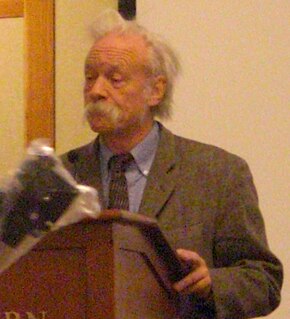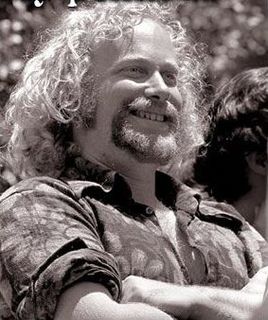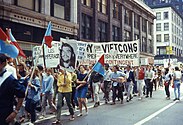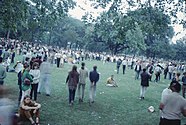
Richard Joseph Daley was an American politician who served as the Mayor of Chicago from 1955 and the chairman of the Cook County Democratic Party Central Committee from 1953 until his death. He's been called "the last of the big city bosses", who were able to control and mobilize American cities. Daley was Chicago's third consecutive mayor from the working-class, heavily Irish-American South Side neighborhood of Bridgeport, where he lived his entire life. He was the patriarch of the Daley family, whose members include Richard M. Daley, another former mayor of Chicago; William M. Daley, a former United States Secretary of Commerce; John P. Daley, a member of the Cook County Board of Commissioners; and Patrick Daley Thompson, an alderman of the Chicago City Council.
The 1968 Democratic National Convention was held August 26–29 at the International Amphitheatre in Chicago, Illinois, United States. As President Lyndon B. Johnson had announced he would not seek reelection, the purpose of the convention was to select a new presidential nominee for the Democratic Party. The keynote speaker was Senator Daniel Inouye (D-Hawaii). Vice President Hubert H. Humphrey and Senator Edmund S. Muskie of Maine were nominated for president and vice president, respectively. The centerpiece of debate was the continuing American military involvement in the Vietnam War and calls to present reforms in the representation by minorities and youth in government and politics.

Abbot Howard Hoffman, better known as Abbie Hoffman, was an American political and social activist who co-founded the Youth International Party ("Yippies"). He was also a leading proponent of the Flower Power movement.

Jerry Clyde Rubin was an American social activist, anti-war leader, and counterculture icon during the 1960s and 1970s. During the 1980s, he became a successful businessman. He is known for being one of the co-founders of the Youth International Party (YIP), whose members were referred to as Yippies.

The Youth International Party (YIP), whose members were commonly called Yippies, was an American youth-oriented radical and countercultural revolutionary offshoot of the free speech and anti-war movements of the late 1960s. It was founded on December 31, 1967. They employed theatrical gestures to mock the social status quo, such as advancing a pig as a candidate for president of the United States in 1968. They have been described as a highly theatrical, anti-authoritarian and anarchist youth movement of "symbolic politics".

The Chicago Seven were seven defendants—Abbie Hoffman, Jerry Rubin, David Dellinger, Tom Hayden, Rennie Davis, John Froines, and Lee Weiner—charged by the US federal government with conspiracy, inciting to riot, and other charges related to anti-Vietnam War and countercultural protests that took place in Chicago, Illinois, on the occasion of the 1968 Democratic National Convention. Bobby Seale, the eighth charged, had his proceedings declared a mistrial, dropping the number of defendants from eight to seven.

A police riot is a riot carried out by the police; a riot that the police are responsible for instigating, escalating or sustaining as a violent confrontation; an event characterized by widespread police brutality; a mass police action that is violently undertaken against civilians for the purpose of political repression. The term "police riot" was popularized after its use in the Walker Report, which investigated the events surrounding the 1968 Democratic National Convention in Chicago to describe the "unrestrained and indiscriminate" violence that the police "inflicted upon persons who had broken no law, disobeyed no order, made no threat."

Rennard Cordon "Rennie" Davis is best known as an American anti-war activist of the 1960s. He was one of the Chicago Seven defendants charged for anti-war demonstrations and large-scale protests at the 1968 Democratic National Convention in Chicago. He had a prominent organizational role in the American anti-Vietnam War protest movement of the 1960s.

Irvin Dana Beal is an American social and political activist, best known for his efforts to legalize marijuana and to promote the benefits of Ibogaine as an addiction treatment. He is a long-term activist in the Youth International Party (Yippies). He founded the Yipster Times in 1972. The newspaper, which was later renamed Overthrow in 1978, ended publication in 1989.
Politics in Chicago through most of the 20th century was dominated by the Democratic Party. Organized crime and corruption were persistent concerns in the city.
Pigasus, also known as Pigasus the Immortal and Pigasus J. Pig, was a 145-pound (66 kg) domestic pig who was nominated for President of the United States as a theatrical gesture by the Youth International Party on August 23, 1968, just before the opening of the Democratic National Convention in Chicago, Illinois. The youth-oriented party was an anti-establishment and countercultural revolutionary group whose views were inspired by the free speech and anti-war movements of the 1960s, mainly the opposition to United States involvement in the Vietnam War.

Stewart Edward "Stew" Albert was an early member of the Yippies, an anti-Vietnam War political activist, and an important figure in the New Left movement of the 1960s.
The Division Street riots were episodes of rioting and civil unrest, which started on June 12 and continued through June 14, 1966. These riots are remembered as a turning point in Puerto Rican civic involvement in Chicago. This was the first riot in the United States attributed to Puerto Ricans.
The Spring Mobilization Committee to End the War in Vietnam, which became the National Mobilization Committee to End the War in Vietnam, was a coalition of antiwar activists formed in 1967 to organize large demonstrations in opposition to the Vietnam War. The organization was informally known as "the Mobe".
The 1968 Chicago riots, in the United States, were sparked in part by the assassination of Martin Luther King Jr. Rioting and looting followed, with people flooding out onto the streets of major cities. Soon riots began, primarily in black urban areas. Over 100 major U.S. cities experienced disturbances, resulting in roughly $50 million in damage.
"The whole world is watching" was a phrase chanted by anti-Vietnam War demonstrators as they were beaten and arrested by police outside the Conrad Hilton Hotel in Chicago during the 1968 Democratic National Convention.

Steven Conliff was a Midwestern-based Native American writer, historian, social satirist, alternative-media publisher and political activist in the 1960s and 1970s.

The King-assassination riots, also known as the Holy Week Uprising, was a wave of civil disturbance which swept the United States following the assassination of Martin Luther King Jr. on April 4, 1968. Many believe it to be the greatest wave of social unrest the United States had experienced since the Civil War. Some of the biggest riots took place in Washington, D.C., Baltimore, Chicago, and Kansas City.
"When the looting starts, the shooting starts" is a phrase originally pronounced by Walter E. Headley, the police chief of Miami, Florida, in response to an outbreak of violent crime during the 1967 Christmas holiday season. He accused "young hoodlums, from 15 to 21", of taking "advantage of the civil rights campaign" that was then sweeping the United States. Having ordered his officers to combat the violence with shotguns, he told the press that "we don't mind being accused of police brutality". The quote may have been borrowed from a 1963 quote from Birmingham, Alabama police chief Bull Connor. The quote was featured in Headley's 1968 obituary published by the Miami Herald.
The George Floyd protests in Chicago are a series of civil disturbances currently occurring since May 26 in the city of Chicago, Illinois. Unrest in the city began as a response to the killing of George Floyd in police custody in Minneapolis on May 25, 2020, and numerous protests, rallies and marches have taken place in Chicago ever since. The demonstrations, supporting justice for Floyd and protesting police brutality, are occurring simultaneously with those of over 100 other cities in the United States. Chicago is among 12 major cities that declared curfews in order to prevent looting and vandalism. On May 31, Mayor Lori Lightfoot asked Illinois Governor J.B. Pritzker to send the Illinois National Guard to Chicago for the first time in 52 years since the 1968 riots in Chicago. The economic damage caused by the disturbances to date exceed $125 million.





















